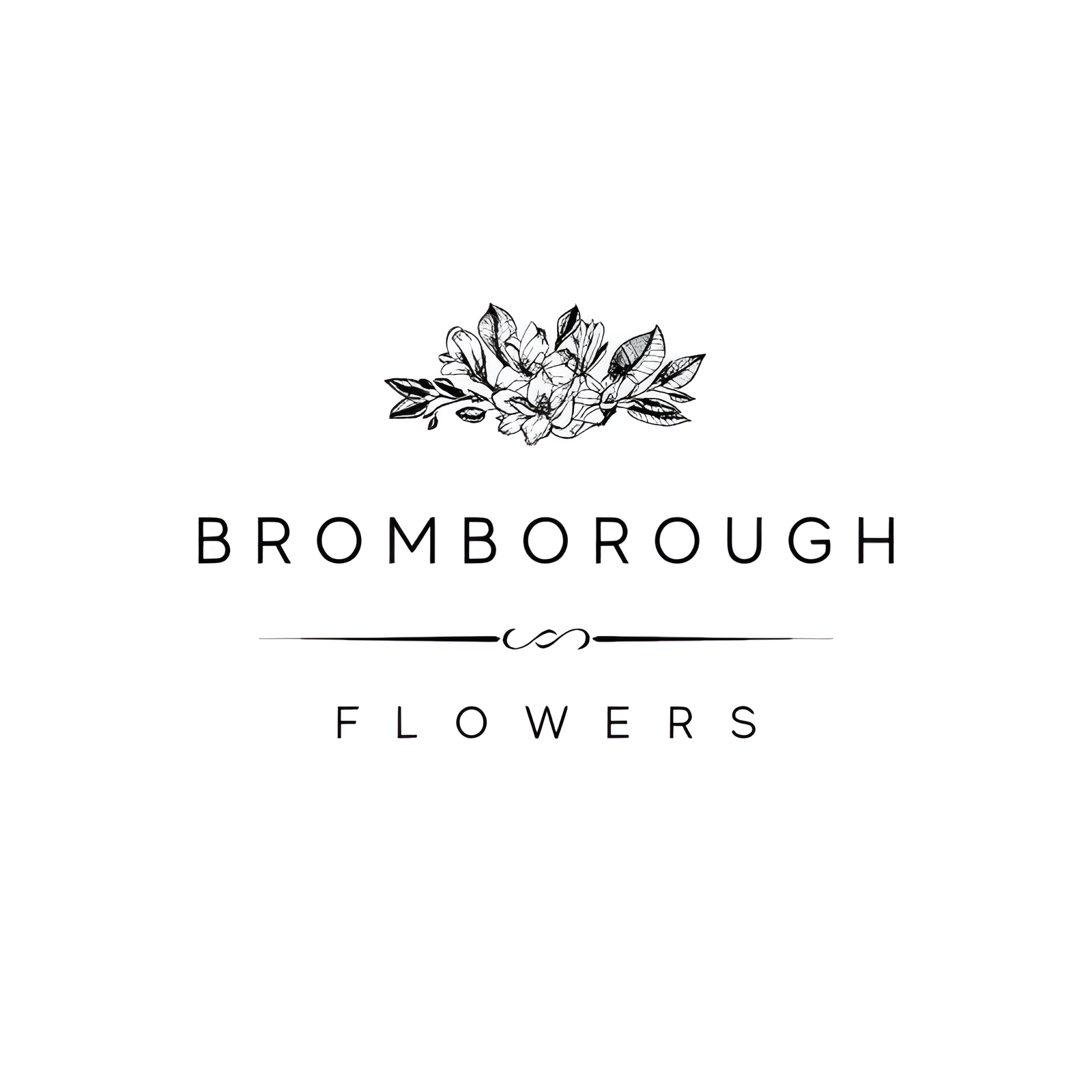When planning the perfect wedding, selecting the right flowers is essential to setting the desired ambiance, and Verbena stands out as an excellent option for many reasons. This versatile flower, known for its clusters of vibrant hues and resilience in warm climates, effortlessly adds a touch of romance and whimsy to any floral arrangement. However, the real allure of Verbena lies not just in its aesthetic appeal but also in its fascinating botanical characteristics, which make it a favorite among florists and brides alike. What exactly makes Verbena so special? Let's explore its unique attributes further.
Flower Overview
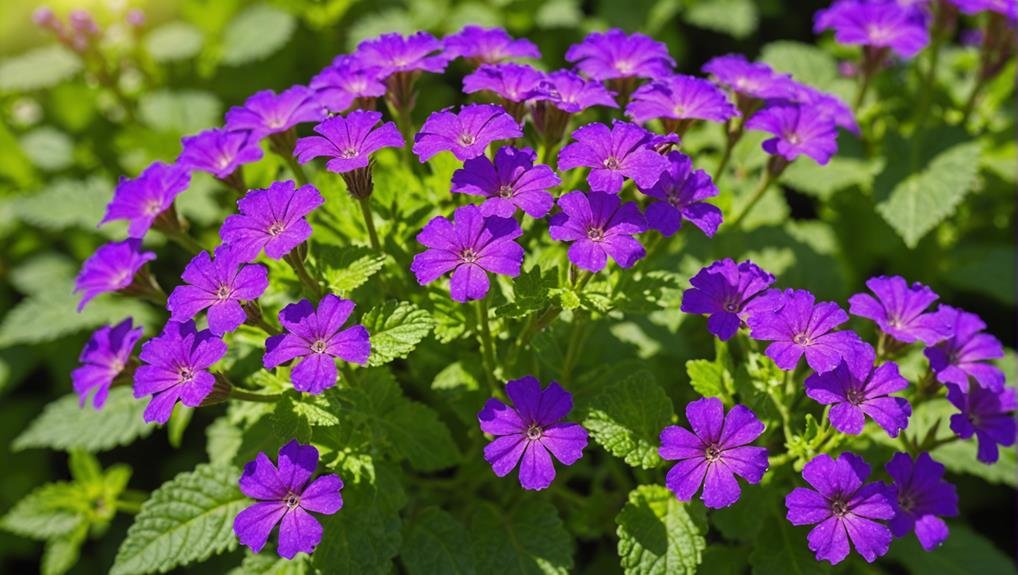
Verbena, a resilient and versatile class of flowering plants, is celebrated for its drought and deer resistance. These plants thrive in environments with partial to full sunlight and well-draining soil, making them an excellent choice for low-maintenance gardens. Once established, Verbena requires minimal care, which adds to its appeal for both novice and experienced gardeners.
Verbena varieties such as Purpletop, Garden, and Tuberous are particularly popular for their vibrant displays, often gracing gardens and patios with a splash of color. Among these, the purple flowers are especially prized for their striking appearance and ability to attract pollinators, adding both beauty and ecological value to any garden setting.
Ideal for hot summer patios, Verbena mixtures can feature a delightful blend of white, scarlet, pink, and purple flowers, often with white centers that create a stunning visual contrast.
When starting Verbena from seeds, it is essential to plant them at a depth of 1/8 inch and space them 6-8 inches apart in full sunlight to ensure optimal growth. This careful planting will yield robust plants that can withstand harsh conditions while enhancing the aesthetic appeal of any outdoor space.
Physical Description
Characterized by their clusters of small, vibrant flowers, Verbena plants display a range of colors from white and pink to purple and red, making them a visually impressive addition to any garden. The genus Verbena belongs to the Verbenaceae family and includes a diverse array of species, encompassing annuals, perennials, and shrubs. This versatility makes Verbena suitable for various horticultural applications, from ground covers to ornamental borders.
The flowers of Verbena are typically small yet abundant, forming dense clusters that are particularly appealing in flower arrangements. These clusters are not only visually enchanting but also fragrant, adding an aromatic dimension to their aesthetic appeal. The long blooming period of Verbena, often extending throughout the growing season, ensures a continuous display of color, making them a popular choice for both garden settings and floral designs.
In addition to their ornamental value, Verbena flowers are known to attract pollinators such as butterflies and bees. This ecological benefit further enhances their appeal for environmentally conscious gardeners.
When incorporated into flower arrangements, Verbena plants contribute both visual variety and a touch of natural elegance, making them a favored option for wedding bouquets and centerpieces.
Available Colour Varieties
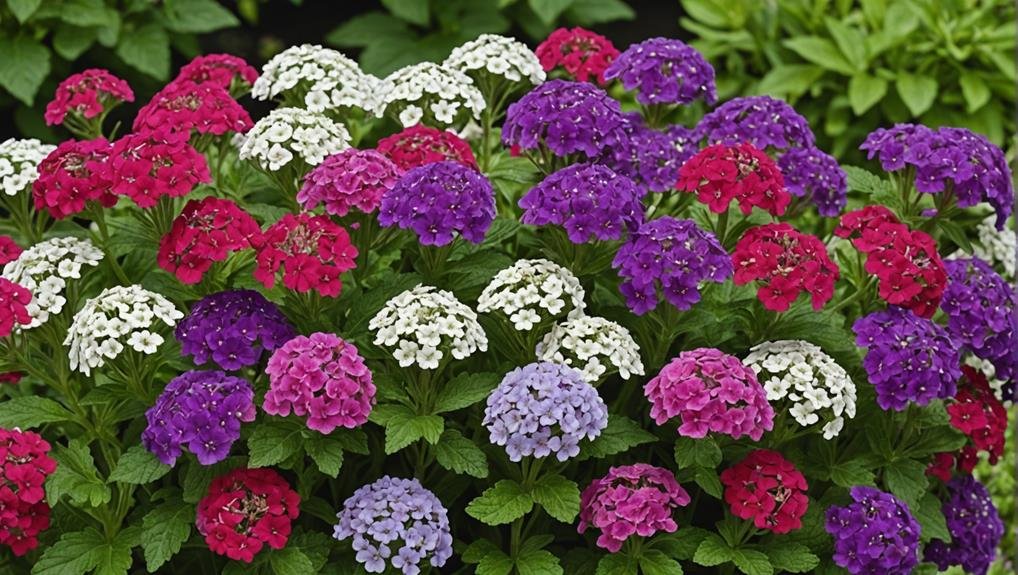
How diverse are the color options for Verbena flowers, showcasing an array of hues from white and scarlet to pink and purple with white centers? The variety of colors available makes Verbena flowers a versatile choice for weddings, as they can complement various themes and color schemes. Their adaptability extends to garden displays, cut flower arrangements, planters, and hanging baskets, providing a vibrant touch to any setting.
The table below highlights the primary color varieties of Verbena flowers and their potential uses in wedding decor:
| Color | Potential Use in Weddings |
|---|---|
| White | Bridal bouquets, aisle decorations |
| Scarlet | Centerpieces, accent flowers in bouquets |
| Pink | Bridesmaids' bouquets, table arrangements |
| Purple | Ceremony arches, reception backdrops |
These flowers not only offer aesthetic appeal but are also practical, given their heat- and drought-resistant nature. This makes them perfect for hot summer patios and outdoor wedding venues. With an average height of 12 inches, Verbena flowers can add vibrant color without overwhelming the overall decor.
Planting a mixture of Verbena colors can create a visually appealing and diverse floral display, ideal for enhancing the ambiance of weddings and other special events. This versatility guarantees that Verbena flowers remain a popular choice for wedding florists and planners.
Latin Name and Taxonomy
Understanding the diverse color varieties of Verbena flowers is improved by exploring their Latin name and taxonomy, which offers insight into their classification and identification.
Verbena, commonly known as vervain, belongs to the Verbenaceae family, a group comprising over 250 species of flowering plants. The Latin name for verbena is Verbena officinalis, a term that not only identifies the plant but also hints at its historical medicinal properties.
Taxonomically, verbena is classified under the genus Verbena, which includes a broad spectrum of species with varying characteristics. This classification system is essential for gardeners, botanists, and florists, as it aids in the accurate identification and categorization of different Verbena varieties.
Each species within this genus boasts unique traits, from diverse flower colors to distinct growth habits, making the taxonomy of Verbena a valuable tool for anyone involved in horticulture or floral design.
Geographical Origins

Native to North and South America, Verbena species are found in diverse regions such as the United States, Chile, and Brazil, thriving in warm climates with full sun and well-drained soil. This flowering plant exhibits remarkable adaptability across various habitats, including meadows, rocky slopes, and open woodlands. The geographical origins of Verbena are notable for their breadth, encompassing a wide range of ecosystems that contribute to the plant's hardiness and versatility.
Verbena has also been naturalized in many parts of the world, including Europe, Africa, and Asia, enhancing its global appeal and ornamental value. The plant's ability to acclimate to different environments has facilitated its spread beyond its native regions, allowing it to flourish in diverse climates and soils. Its success in various habitats has been a key factor in its widespread cultivation and popularity in horticulture.
Over the years, different Verbena varieties have been cultivated and hybridized, resulting in an array of colors, sizes, and growth habits. These characteristics have made Verbena a favored choice among gardeners and floral enthusiasts, particularly in wedding floral arrangements where its vibrant hues and delicate structure add a touch of elegance.
Season Availability
Verbena flowers are primarily available from late spring to early fall, offering an ideal option for weddings during these seasons. Their seasonal presence guarantees that couples can enjoy fresh and vibrant blooms that enhance the overall aesthetic of their wedding arrangements. Verbena's peak blooming period coincides with the warmer months, making them a perfect choice for spring, summer, and early fall weddings.
Choosing verbena during its seasonal presence has several advantages:
- Vibrant Colors: Verbena flowers bloom profusely in warmer months, adding rich and vivid hues to floral arrangements.
- Freshness: Opting for verbena in its natural season assures the flowers are fresh, boosting their visual appeal and longevity.
- Cost-Effectiveness: Flowers in season are generally more affordable than those that are out of season, assisting in budget-friendly wedding planning.
- Availability: Making sure your flowers are in season means they are more readily available, reducing the risk of last-minute shortages.
Incorporating verbena into wedding florals during these months not only aligns with their natural growth cycle but also provides a beautiful and cost-effective solution. This makes verbena a popular choice for wedding planners and couples alike.
Growing Conditions
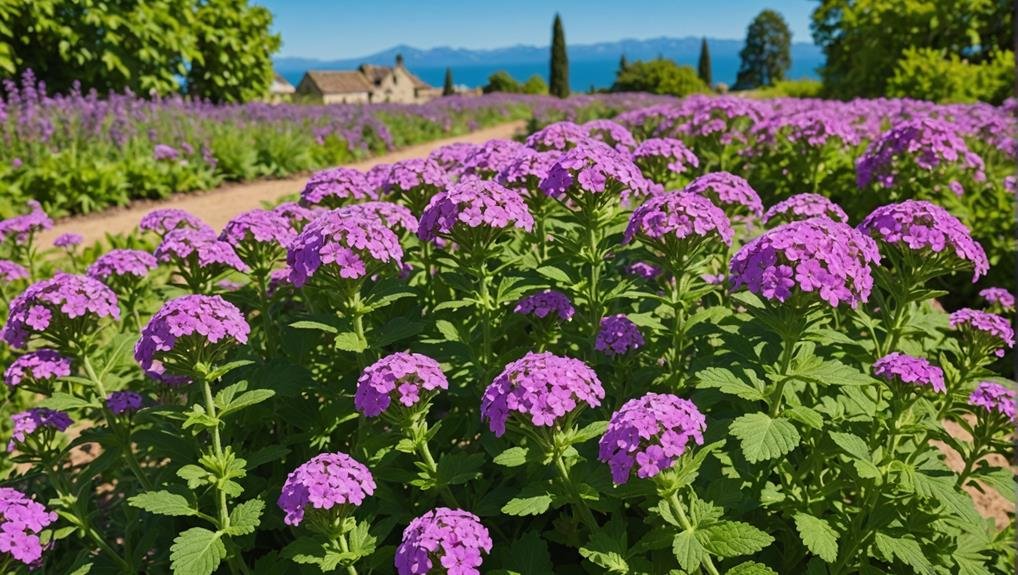
Verbena, often thriving in well-drained soil and full sun, requires 6-8 hours of direct sunlight daily to produce its finest blooms. This perennial is well-suited to a variety of garden settings, provided its basic needs are met. Best growing conditions for verbena include soil amended with compost to promote healthy root development. While verbena can tolerate moderately moist conditions, it is crucial to avoid compacted or clay soil, which can lead to harmful issues such as root rot.
Spacing is another crucial factor in ensuring strong growth. Verbena plants should be spaced 8-12 inches apart to allow sufficient air circulation and prevent overcrowding, which can contribute to disease. Notably, verbena displays remarkable resilience in the face of challenging environmental conditions. Its heat and drought tolerance make it an excellent choice for gardens in warmer climates where water conservation is a priority.
Once established, verbena requires minimal maintenance. Its ability to withstand periods of drought reduces the need for frequent watering, making it a practical and sustainable option for eco-conscious gardeners. Overall, the combination of heat tolerance, drought resistance, and minimal care requirements emphasizes verbena's suitability for diverse garden landscapes.
Cultural Significance
Throughout history, verbena has held deep cultural significance, symbolizing healing, protection, and love across various traditions. Revered in ancient times, this plant was believed to have the power to ward off evil spirits and bring good luck, making it a cherished addition to any wedding day. Its fragrant, delicate blooms are not only visually appealing but also steeped in meaningful symbolism, adding a layer of depth to wedding celebrations.
Verbena's multifaceted cultural importance can be summarized as follows:
- Healing: Traditionally, verbena was used in various healing rituals and herbal remedies, signifying its role in promoting wellness and recovery.
- Protection: Known for its protective qualities, verbena was often placed in homes and carried by individuals to safeguard against negative energies and misfortune.
- Love: The plant's association with love made it a popular choice in wedding ceremonies, where it was believed to strengthen the bond between couples.
- Creativity and Inspiration: Verbena is also linked to creativity and inspiration, fostering a sense of joy and happiness, which are essential elements for a memorable wedding day.
Incorporating verbena into wedding festivities not only enhances the aesthetic appeal but also honors these rich cultural traditions.
Typical Use in Weddings
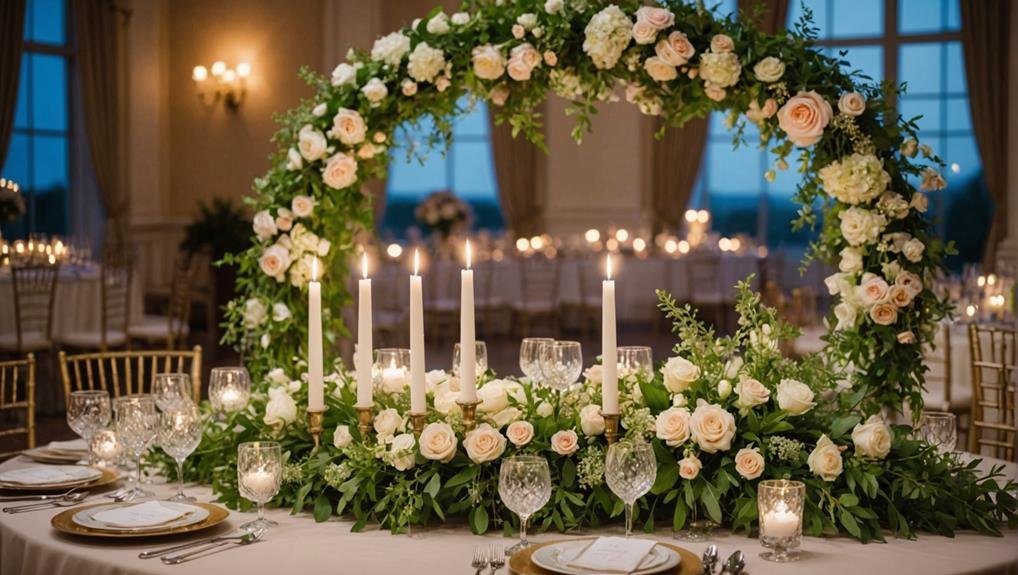
Incorporating delicate clusters of small flowers in various colors, verbena imparts a whimsical and romantic touch to bridal bouquets, centerpieces, and floral arrangements. Its versatility and heat tolerance make verbena an optimal choice for summer weddings and outdoor ceremonies, where maintaining fresh and vibrant blooms can be challenging. Verbena's ability to thrive in warm conditions guarantees that floral arrangements remain stunning throughout the event.
Verbena's allure is not confined to bouquets; it also excels in enhancing wedding décor through its use in hanging baskets. These baskets can adorn ceremony arches, reception venues, and even outdoor seating areas, adding a touch of nature's elegance to the overall ambiance. The cascading beauty of verbena in hanging baskets creates a lush, enchanting atmosphere that complements both formal and rustic wedding themes.
Furthermore, verbena's low maintenance and long-lasting blooms contribute to its popularity among florists and brides alike. This plant's resilience means less concern about wilting flowers, allowing couples to focus on enjoying their special day.
Whether used in elaborate floral installations or simple, understated arrangements, verbena consistently delivers a fresh, romantic aesthetic, making it a favored choice for wedding flowers.
Alternative Flower Types
When planning wedding floral arrangements, it is essential to explore alternative flower types that provide both aesthetic diversity and complementary characteristics to verbena. Incorporating different flowers not only enhances the visual appeal but also adheres to sustainable practices by diversifying your floral selection.
Here are four alternative flower types to contemplate:
- Lavender: Known for its soothing scent and delicate purple hues, lavender pairs beautifully with verbena varieties like Meteor Shower and Garden Verbena. Its drought-resistant nature aligns with sustainable practices, making it a practical choice.
- Echinacea: With its vibrant colors ranging from pink to orange, echinacea offers a striking contrast to the typically cooler tones of verbena. Additionally, it attracts pollinators and thrives on minimal care, contributing to an eco-friendly wedding setup.
- Dusty Miller: This foliage plant's silvery-gray leaves provide a fantastic textural contrast to verbena's vivid blooms. Dusty Miller is also known for its hardiness and low water requirements, aligning well with sustainable gardening efforts.
- Snapdragon: Offering a spectrum of colors from white to deep red, snapdragons add height and structure to floral arrangements. Their long-lasting blooms and ability to thrive in various conditions make them an excellent complement to verbena.
